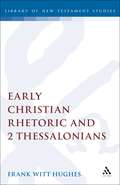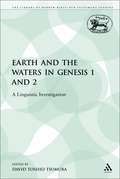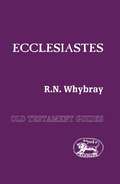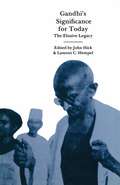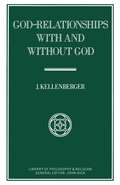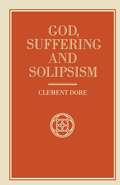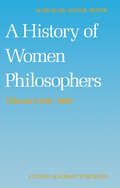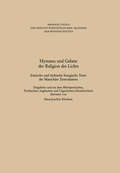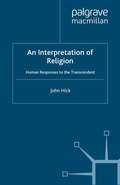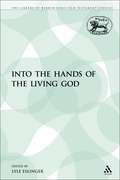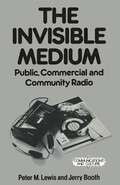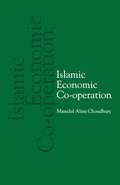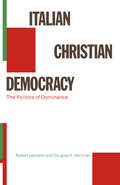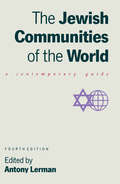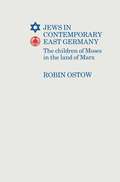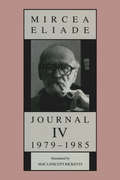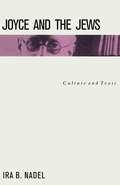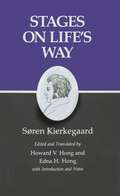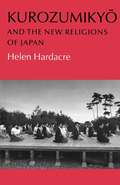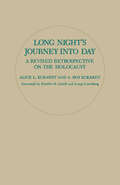- Table View
- List View
Early Christian Rhetoric and 2 Thessalonians (The Library of New Testament Studies #30)
by Frank Witt Hughes2 Thessalonians is one of the most enigmatic letters in the New Testament, primarily because of its repeated insistence on its authorship by Paul, coupled with its warnings against forgery of Pauline letters. Modern scholarship has made a number of advances in the study of this letter, but the question of the authorship and purpose remain quite open. Hughes gives a detailed investigation of Graeco-Roman rhetorical traditions and their relationship to letters, and develops a consensus model for the identification of the various conventional parts of rhetorical discourses. He then offers an interpretation of 2 Thessalonians according to these rhetorical traditions. Given the rhetoric thus identified in the letter, an innovative theory is developed against Paul's authorship of 2 Thessalonians. In his final chapters, he suggests ways in which the pseudo-Pauline letters of the New Testament witness to a multiplicity of Pauline theologies after the Apostle's death-a diverse and pluriform 'legacy of Paul'.
Early Christian Rhetoric and 2 Thessalonians (The Library of New Testament Studies #30)
by Frank Witt Hughes2 Thessalonians is one of the most enigmatic letters in the New Testament, primarily because of its repeated insistence on its authorship by Paul, coupled with its warnings against forgery of Pauline letters. Modern scholarship has made a number of advances in the study of this letter, but the question of the authorship and purpose remain quite open. Hughes gives a detailed investigation of Graeco-Roman rhetorical traditions and their relationship to letters, and develops a consensus model for the identification of the various conventional parts of rhetorical discourses. He then offers an interpretation of 2 Thessalonians according to these rhetorical traditions. Given the rhetoric thus identified in the letter, an innovative theory is developed against Paul's authorship of 2 Thessalonians. In his final chapters, he suggests ways in which the pseudo-Pauline letters of the New Testament witness to a multiplicity of Pauline theologies after the Apostle's death-a diverse and pluriform 'legacy of Paul'.
The Earth and the Waters in Genesis 1 and 2: A Linguistic Investigation (The Library of Hebrew Bible/Old Testament Studies)
by David Toshio TsumuraEnormous amounts of interpretive efforts have gone into the first book of the Hebrew Bible. In modern critical studies of Genesis, for instance, it is often suggested that the nature of the "earth-waters" relationship in Chapter 1 is totally different from that in Chapter 2. Professor Tsumura here offers a linguistic analysis of some key terms related to the initial situation of the earth in its relationship with the waters in Gen 1:2 and Gen 2:5ff that helps to clarify some of the hermeneutic issues at stake.
Ecclesiastes (Old Testament Guides)
by R. Norman WhybrayEcclesiastes is at once a strange book and a modern one, at once enigmatic and curiously familiar. Here we find a man detached from the world and yet intensely aware of it, setting down in writing his thoughts about human life. Yet from the very first his readers have been unable to agree about his basic attitude to life. Whybray sorts through the options by asking questions regarding the author, his times, his language and his ideas.
Gandhi's Significance For Today
by John Hick Lamont Hempel Joanne Clarke Dillman John D Maguire Conrad Edick WrightGod-Relationships With and Without God: Relationships With And Without God (Library Of Philosophy And Religion Ser.)
by J KellenbergerA History of Women Philosophers: Medieval, Renaissance and Enlightenment Women Philosophers A.D. 500–1600 (History of Women Philosophers #2)
by Mary Ellen Waitheaspirations, the rise of western monasticism was the most note worthy event of the early centuries. The importance of monasteries cannot be overstressed as sources of spirituality, learning and auto nomy in the intensely masculinized, militarized feudal period. Drawing their members from the highest levels of society, women's monasteries provided an outlet for the energy and ambition of strong-willed women, as well as positions of considerable authority. Even from periods relatively inhospitable to learning of all kinds, the memory has been preserved of a good number of women of education. Their often considerable achievements and influence, however, generally lie outside even an expanded definition of philo sophy. Among the most notable foremothers of this early period were several whose efforts signal the possibility of later philosophical work. Radegund, in the sixth century, established one of the first Frankish convents, thereby laying the foundations for women's spiritual and intellectual development. From these beginnings, women's monasteries increased rapidly in both number and in fluence both on the continent and in Anglo-Saxon England. Hilda (d. 680) is well known as the powerful abbsess of the double monastery of Whitby. She was eager for knowledge, and five Eng lish bishops were educated under her tutelage. She is also accounted the patron of Caedmon, the first Anglo-Saxon poet of religious verse. The Anglo-Saxon nun Lioba was versed in the liberal arts as well as Scripture and canon law.
Hymnen und Gebete der Religion des Lichts: Iranische und türkische liturgische Texte der Manichäer Zentralasiens (Abhandlungen der Rheinisch-Westfälischen Akademie der Wissenschaften)
by Hans-Joachim KlimkeitDie hier vorgelegten Hymnen und Gebete der Manichäer Zentralasiens sind Neubearbeitungen jener gnostischen Texte, die von den vier Preußischen "Turfan Expeditionen " zwischen 1902 und 1914 vornehmlich in der Oase T urfan am nörd lichen Rand der Taklamakan-Wüste gefunden und von diversen Wissenschaftlern seit 1904 bearbeitet wurden. Hinzu kommen einige von Sir AUREL STEIN und PAUL PELLIOT in Tun-huang geborgene türkisch-manichäische Texte. Die Preußische Akademie der Wissenschaften zu Berlin machte es sich in den ersten Jahrzehnten dieses Jahrhunderts zur besonderen Aufgabe, die neugefundenen manichäischen Texte, auf deren allgemeine Bedeutung kein geringerer als der Theologe RUDoLF BULTMANN verweisen sollte, zu erschließen. Ist diese Arbeit, die bereits 1904 durch die ersten Publikationen von F. W. K. MÜLLER eingeleitet wurde, vornehmlich in den zwanziger und dreißiger Jahren vorangetrieben worden, wobei Iranisten wie F. C. ANDREAS, W. B. HENNING und W. LENTZ (in Verbindung mit E. W ALDSCHMIDT) und Turkologen wie A. VON LE COQ, W. BANG und A. VON GABAIN maßgeblich be teiligt waren, so war doch angesichts des Fortschritts der Iranistik und Turkologie, zu dem teils diese Wissenschaftler und ihre Schüler selbst beigetragen haben, eine Neubearbeitung der teilweise vor mehr als sechzig Jahren übersetzten Texte not wendig.
An Interpretation of Religion: Human Responses to the Transcendent
by J. HickA new and groundbreaking investigation which takes full account of the finding of the social and historical sciences whilst offering a religious interpretation of the religions as different culturally conditioned responses to a transcendent Divine Reality. Written with great clarity and force, and with a wealth of fresh insights, this major work (based on the author's Gifford Lectures of 1986-7) treats the principal topics in the philosophy of religion and establishes both a basis for religious affirmation today and a framework for the developing world-wide inter-faith dialogue.
Into the Hands of the Living God (The Library of Hebrew Bible/Old Testament Studies)
by Lyle EslingerInto the Hands of the Living God is Lyle Eslinger's second study of Deuteronomistic literature. This book is devoted to studies of key texts (Joshua 1-9; Judges 1-2; 1 Samuel 12; 1 Kings 8; 2 Kings 17) or concepts (the success/failure of the conquest; the exile and theodicy) in these narratives. Eslinger's readings are unorthodox and challenging, both for readers from the communities of faith and for critical scholarship. The Deuteronomistic narratives are here shown to be far from being a vindication of the ways of God at Israel's expense. Rather, in these narratives God, no less than Israel's leaders, has his hands soiled in the machinations that end in Babylon. What the Deuteronomistic history offers is, rather, dispassionate analysis of the problems, some unavoidable, that predetermined the failure of the covenant relationship. The collection of carefully worked out close readings of the biblical text in this volume provides a new critical vantage point from which one can reassess conventional historical-critical readings of these colourful books.
The Invisible Medium: Public, Commercial and Community Radio (Communications and Culture)
...the book is recommended and should be read by every member of the IRTC. Those working in radio will also find it rewarding.' - Playback
Italian Christian Democracy: The Politics of Dominance
by Robert Leonardi Douglas A. WertmanA study of the Italian Christian Democratic Party from its birth to the present day. It is the most successful political party in any Western democracy and has been in power since 1945. This book analyzes its ideological foundations, electorate, organization and ties to the Catholic world.
Jewish Communities of the World
by Anthony LermanThis fourth edition attempts to provide an up-to-date and comprehensive guide to Jewish life and institutions in 98 national communities worldwide. Entries include a brief historical outline and sections on legal status, communal organizations, religious life, education and welfare.
Jews in Contemporary East Germany: The Children of Moses in The Land of Marx
by Robin OstowThis book is the result of a series of interviews of Robin Ostow with Jews in the German Democratic Republic. For the first time since the founding of the East German state in 1949 Jews have been allowed to speak openly. Jewish men and women of different ages were interviewed.
Journal IV, 1979-1985
by Mircea EliadeJournal IV is the first publication, in a translation from the Romanian manuscript, of the journal that Mircea Eliade kept during the last seven years of his life. In this period, Eliade is ensconced as a famous scholar—his works are being translated into many languages and books about him arrive regularly in the mail. His encounters with scholars of like repute are recorded in the journal; after a party in Paris, Eliade shares a taxi with Claude Lévi-Strauss and inadvertently makes off with his raincoat. Running like a fault line through the peak of his success, however, is Eliade's painful awareness of his physical decline—failing vision, arthritic hands, and continual fatigue. Again and again he repeats how little time he has to finish the projects he is working on—his autobiography, the third and fourth volumes of his History of Religious Ideas, and the duties associated with his editorship of the Encyclopedia of Religion. He poignantly recounts the sharpest blow: the disorganization and eventual destruction by fire of his personal library. Within the scope of Journal IV Eliade and his world go to ruin. What does not decline is the vivid and persistent voice of Eliade the writer, an unbreaking voice that—with death only months away—plans a reply to critics, plots out an article, and ruminates on characters to people another novella.
Journal IV, 1979-1985
by Mircea EliadeJournal IV is the first publication, in a translation from the Romanian manuscript, of the journal that Mircea Eliade kept during the last seven years of his life. In this period, Eliade is ensconced as a famous scholar—his works are being translated into many languages and books about him arrive regularly in the mail. His encounters with scholars of like repute are recorded in the journal; after a party in Paris, Eliade shares a taxi with Claude Lévi-Strauss and inadvertently makes off with his raincoat. Running like a fault line through the peak of his success, however, is Eliade's painful awareness of his physical decline—failing vision, arthritic hands, and continual fatigue. Again and again he repeats how little time he has to finish the projects he is working on—his autobiography, the third and fourth volumes of his History of Religious Ideas, and the duties associated with his editorship of the Encyclopedia of Religion. He poignantly recounts the sharpest blow: the disorganization and eventual destruction by fire of his personal library. Within the scope of Journal IV Eliade and his world go to ruin. What does not decline is the vivid and persistent voice of Eliade the writer, an unbreaking voice that—with death only months away—plans a reply to critics, plots out an article, and ruminates on characters to people another novella.
Journal IV, 1979-1985
by Mircea EliadeJournal IV is the first publication, in a translation from the Romanian manuscript, of the journal that Mircea Eliade kept during the last seven years of his life. In this period, Eliade is ensconced as a famous scholar—his works are being translated into many languages and books about him arrive regularly in the mail. His encounters with scholars of like repute are recorded in the journal; after a party in Paris, Eliade shares a taxi with Claude Lévi-Strauss and inadvertently makes off with his raincoat. Running like a fault line through the peak of his success, however, is Eliade's painful awareness of his physical decline—failing vision, arthritic hands, and continual fatigue. Again and again he repeats how little time he has to finish the projects he is working on—his autobiography, the third and fourth volumes of his History of Religious Ideas, and the duties associated with his editorship of the Encyclopedia of Religion. He poignantly recounts the sharpest blow: the disorganization and eventual destruction by fire of his personal library. Within the scope of Journal IV Eliade and his world go to ruin. What does not decline is the vivid and persistent voice of Eliade the writer, an unbreaking voice that—with death only months away—plans a reply to critics, plots out an article, and ruminates on characters to people another novella.
Journal IV, 1979-1985
by Mircea EliadeJournal IV is the first publication, in a translation from the Romanian manuscript, of the journal that Mircea Eliade kept during the last seven years of his life. In this period, Eliade is ensconced as a famous scholar—his works are being translated into many languages and books about him arrive regularly in the mail. His encounters with scholars of like repute are recorded in the journal; after a party in Paris, Eliade shares a taxi with Claude Lévi-Strauss and inadvertently makes off with his raincoat. Running like a fault line through the peak of his success, however, is Eliade's painful awareness of his physical decline—failing vision, arthritic hands, and continual fatigue. Again and again he repeats how little time he has to finish the projects he is working on—his autobiography, the third and fourth volumes of his History of Religious Ideas, and the duties associated with his editorship of the Encyclopedia of Religion. He poignantly recounts the sharpest blow: the disorganization and eventual destruction by fire of his personal library. Within the scope of Journal IV Eliade and his world go to ruin. What does not decline is the vivid and persistent voice of Eliade the writer, an unbreaking voice that—with death only months away—plans a reply to critics, plots out an article, and ruminates on characters to people another novella.
Joyce and the Jews: Culture and Texts
by Ira Bruce HadelNadel examines Joyce's identification with the dislocated Jew after his exodus from Ireland and analyzes the influence which Rabbinical hermeneutics and Judaic textuality had on his language. Biographical and historical information is used as well as Joyce's texts and critical theory.
Kierkegaard's Writings, XI, Volume 11: Stages on Life's Way
by Søren Kierkegaard Howard V. Hong Edna H. HongStages on Life's Way, the sequel to Either/Or, is an intensely poetic example of Kierkegaard's vision of the three stages, or spheres, of existence: the esthetic, the ethical, and the religious. With characteristic love for mystification, he presents the work as a bundle of documents fallen by chance into the hands of "Hilarius Bookbinder," who prepared them for printing. The book begins with a banquet scene patterned on Plato's Symposium. (George Brandes maintained that "one must recognize with amazement that it holds its own in this comparison.") Next is a discourse by "Judge William" in praise of marriage "in answer to objections." The remainder of the volume, almost two-thirds of the whole, is the diary of a young man, discovered by "Frater Taciturnus," who was deeply in love but felt compelled to break his engagement. The work closes with a letter to the reader from Taciturnus on the three "existence-spheres" represented by the three parts of the book. Stages on Life's Way not only repeats themes, characters, and pseudonymous authors of the earlier works but also goes beyond them and points to further development of central ideas in Concluding Unscientific Postscript. ?
Kierkegaard's Writings, XI, Volume 11: Stages on Life's Way
by Søren Kierkegaard Howard V. Hong Edna H. HongStages on Life's Way, the sequel to Either/Or, is an intensely poetic example of Kierkegaard's vision of the three stages, or spheres, of existence: the esthetic, the ethical, and the religious. With characteristic love for mystification, he presents the work as a bundle of documents fallen by chance into the hands of "Hilarius Bookbinder," who prepared them for printing. The book begins with a banquet scene patterned on Plato's Symposium. (George Brandes maintained that "one must recognize with amazement that it holds its own in this comparison.") Next is a discourse by "Judge William" in praise of marriage "in answer to objections." The remainder of the volume, almost two-thirds of the whole, is the diary of a young man, discovered by "Frater Taciturnus," who was deeply in love but felt compelled to break his engagement. The work closes with a letter to the reader from Taciturnus on the three "existence-spheres" represented by the three parts of the book. Stages on Life's Way not only repeats themes, characters, and pseudonymous authors of the earlier works but also goes beyond them and points to further development of central ideas in Concluding Unscientific Postscript. ?
Kurozumikyo and the New Religions of Japan
by Helen HardacreThe description for this book, Kurozumikyo and the New Religions of Japan, will be forthcoming.
Long Night's Journey into Day: A Revised Retrospective on the Holocaust
by Alice L. Eckardt A. Roy Eckardt Irving Greenberg Franklin H. LittellLong Night's Journey Into Day is a stimulating and provocative attempt to deal with the impact and meaning of the Holocaust within contemporary Christian and Jewish thought. To Jews, the Holocaust is the most terrible happening in their history, but it must also be seen as a Christian event. The Eckardts call for a radical rethinking of the Christian faith in the light of the Holocaust, examining such issues as the relation between human and demonic culpability, the charge of God's guilt, and the reality of forgiveness. They clarify the theological meaning of the Holocaust and the responsibility that must be borne for it by the Christian Church, and discuss possible responses to it as exemplified in the writings of selected modern theologians and church councils. This enlarged and revised edition takes into account new topics and developments, including the issue of Austrian responsibility for the Holocaust, the significance and aftermath of Bitburg, and antisemitism in German feminism. More detailed attention is also given to other modern genocides and occasions of humanly-caused mass death. Additional literary, historical, and religious works are considered and appropriate quotations incorporated. The new edition also includes a revised preface, an updated bibliography and two new appendices.
